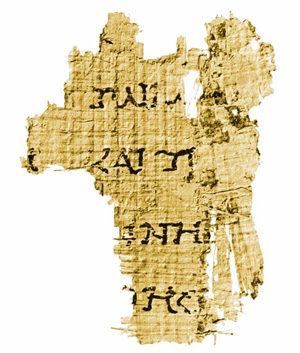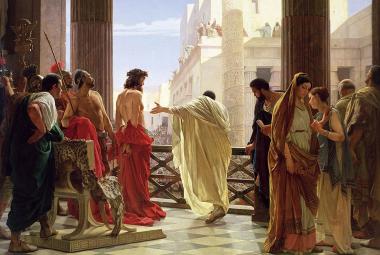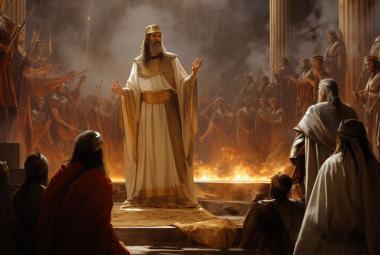More than twenty centuries have come and gone since this extraordinary rabbi walked the territories of his homeland of ancient Israel. Throughout these 2,000 years, the Apostle John’s pronouncement about his teacher that we’ve just quoted has proven to be amazingly prescient: literally thousands of men and women have spoken, instructed, slandered, lectured, theorized, gossiped, libeled, and written regarding the man who called himself “the Good Shepherd.”
Over the last several decades, Dr. Missler and I have contributed in no insignificant way to what has been written about Jesus of Nazareth. Dr. Missler has published dozens of books and has released literally millions of audio and video recordings relating to exposition of the Scriptures as our New Zealand and Coeur d’Alene, Idaho based Koinonia Institute “think tank” has gone about its mission of equipping God’s people with effective tools to defend their faith in what is becoming an increasingly hostile environment for Christians. I’ve addressed a number of annual Strategic Perspectives Conferences on behalf of Koinonia Institute and serve on the Board of Directors of Koinonia House, the publishing arm of the Koinonia Institute. I’ve also served as Executive Director of the ISV Foundation, which produces The Holy Bible: International Standard Version, which I worked on as an Associate Editor and translator of a significant portion of the Hebrew Scriptures.
During late January 2014, Dr. Missler and I were talking about the cultural mythology that affects—or, more accurately, infects—our largely Christ-rejecting culture concerning the person of Jesus of Nazareth. As we continued talking, it occurred to us that perhaps we should address the subject of the person of Jesus himself in some depth. The result of those discussions is this book, which is also the first formal textbook to be produced for Koinonia Institute students and for friends of this ministry throughout the world. Our intention is to release the material contained in this work as a printed book, an eBook in a variety of popular formats, a DVD series, and a PowerPoint presentation suitable for use by teachers of apologetics, which is that branch of systematic theology that deals with the defense of the Christian faith.
The Person of Jesus: Variants on the Literary Fiction View
Was He a Legend?
Most non-Christians seem to waver between two extremes when it comes to their opinions regarding Jesus of Nazareth. On one extreme, there’s the literary fiction view: some folk say he never existed at all. These people claim that the exalted view of the rabbi from Nazareth that is described within the pages of the New Testament is a historical fiction crafted in later generations many decades after the apostles had died.
Some who hold this view point to apparent parallels in other cultures to some of the same themes that are contained in the Bible about a dying god, who is brought back to life after his death. Adherents of this view claim that some ancient cultures found themes of the “dying god” in the annual cycle of seasons. Because the “dying god” motif pervades the ancient cultures of nascent humanity—the phenomenon is almost a universal constant throughout the ancient world—these people conclude that the Christian history of these events must have been copied from ancient, pagan prototypes. In short, they believe that Christianity appropriated the “dying god” motif and applied it to the rabbi from Nazareth after his untimely death.
But the conservative Christian community responds that God’s plan of salvation was crafted before the foundation of the world and was discernible in seed form far back in human history. For example, God’s slaying of some innocent animals for Adam and Eve introduced the concept of animal sacrifice while providing clothing for our first fallen parents. Therefore we should not find it unusual that the existence of “dying god” cultural metaphors would serve as a universal, natural, and God-ordained typological prophecy of what would one day come to pass in the life, death, and resurrection of the God who became incarnate in the person of Jesus of Nazareth. Conservative Christians say the “dying god” motif was a universal type, a cultural prophecy, if you will, of God’s plan to redeem fallen humanity by the sacrifice of his own Son.
Others claim that the record of the life of Jesus was corrupted in later generations from an essential kernel of truth. These people believe that it has become their task to recreate the true “historical” Jesus by separating the “real” man from the fog of later literary fiction. When facilitated by pseudo-scholarly inquiry, so-called “Jesus Seminars” convene to discuss the man’s life, where committee members pour over the New Testament’s Gospel records and then cast their votes as to what quotes attributed to Jesus reflect the “historical” Jesus. Predictably, these mockers of all things evangelical conclude that virtually all of the statements that the New Testament records say were actually said by the man were never actually uttered by him, since these statements were attributed to him by misguided and mythologically minded manipulators of the “historical” Jesus of Nazareth, who in their view probably never existed to begin with.
But this view that Jesus is only a literary legend is refuted by the textual transmission history of the written record we call the New Testament. Modern conservative scholarship has pretty much concluded that all books of the New Testament were written and were being circulated in the early churches of the Roman Empire well before the destruction of the Jerusalem Temple in 70 AD, perhaps as early as the days of Nero’s pogrom that emanated from Rome. There’s no textual transmission evidence suggesting that early accounts about Jesus existed which do not contain records of his miracles and of his astonishing claims to deity.

At least one Dead Sea Scroll scholar has detected what may constitute a fragment from the Gospel of Mark among the scrolls uncovered within the ancient Qumran community. Among the Dead Sea scrolls, a 7Q5 papyrus fragment has led to an argument being proferred by José O’Callaghan in his work ¿Papiros neotestamentarios en la cueva 7 de Qumrán? (New Testament Papyri in Cave 7 at Qumran?) suggesting that the 7Q5 fragment is a fragment of the Gospel of Mark 6:52-53. The illustration at right gives a clear picture of how much text is conserved on the fragment 7Q5.1 O’Callaghan’s views, first reported in 1972, were later reasserted and expanded by German scholar Carsten Peter Thiede in his work The Earliest Gospel Manuscript? in 1982.
As a point of historical fact, there’s credible evidence that some of the Apostle Paul’s early works, such as 1 Thessalonians, 2 Thessalonians, and Galatians, were composed and in general circulation as early as 50 AD. Copies of lectionaries (citations of Biblical books, including quotations from the New Testament used in early church worship services) were heavily circulated in languages other than Greek (including Syriac and Coptic). Many of them have been dated to the earliest days of the second century AD, which tends to suggest that the New Testament records had been recorded and placed into general circulation throughout the Roman Empire long enough to war-rant their translation into languages other than Greek for use by Christians who lived outside of the influence and reach of Hellenistic culture.
It’s abundantly evident from these early church documents that Jesus was being worshipped as God from the earliest days following that event described in the Gospels as the resurrection of Jesus from the dead. Ac-cordingly, conservative Christians refute the view that there came about a gradual evolution of theistic mythology regarding the person of Jesus by responding that there wasn’t enough time, counting from the first days of the early church until the first pages of the New Testament documents were recorded, for a historical mythology to develop.
Assuming that Jesus was executed ca. 32 AD and that the earliest New Testament documents were composed ca. 50 AD, a gap of only about eighteen years separates the historical events from the composition of the historical records.
If any of the historical claims of the New Testament in general and of the Gospels in particular were specious or of dubious reliability, enough eyewitnesses remained at the time of their composition to have resulted in the existence of rebuttal testimonies or downright denials to have corrected false stories regarding the life, death, and resurrection events that were being circulated widely about Jesus.
But no such rebuttals have been discovered. As a point of textual transmission certainty, the evidence contained in the historical records points to attempts by the enemies of Jesus not so much to deny and refute the eyewitness testimony, but rather to explain away the events as the outworking of a conspiracy on the part of the apostles to make it appear that Jesus had risen from the dead by removing his body from the tomb of Joseph of Arimathea.
Jesus in Non-Biblical Historical Resources
People who deny the historicity of the man Jesus only do so by ignoring the plain evidence of recorded history. Several classical references to Jesus survive from non-biblical Greek or Latin sources. Given their non-Christian bias, these accounts are almost universally hostile to Christianity. as they attempt to explain away the miraculous nature of Jesus and the events that surrounded his life. However, when we examine these admittedly hostile accounts, we can discern the following:
- A group that called itself “Christians” derived its name from the Latin term Christus, a transliteration of the Greek term Christos, which means “Christ” and was used as a title for Jesus of Nazareth.
- Their leader lived in Judea and was executed there during the reign of Tiberius under Governor Pontius Pilate.
- This new movement involved what one non-Christian writer referred to as “a most mischievous superstition,” a reference to belief by Christians that Jesus rose from the dead shortly after his execution by crucifixion during a full moon festival, which the New Testament calls the Passover Festival of the Jews.
- This new movement began in Judea and spread rapidly to Rome.
- Early Christians considered Jesus to be a divine being, though virtually none of the Roman sources were able to articulate clearly what they or the Christians meant by this term, only that this claim by the Christians was considered to be a national security threat to the Roman government.
Set forth below approximately in chronological order is a summary list of historical citations from Roman-era authors whose mention of Jesus of Nazareth and his early followers tends to demonstrate that Jesus was not only not a legend, but that his reputation as being decidedly different from normal human beings continued to disconcert his detractors, even many decades after the occurrence of the events described in the Gospels and the Book of Acts:
Thallus (ca. 52 AD) and Africanus (ca. 221 AD)
Arguably the earliest non-biblical writer to mention the events of the New Testament surrounding the person of Jesus is so ancient that his writings are no longer extant. But Julius Africanus, writing in his Chronography 18:1 (ca. 221 AD) quotes Thallus as having previously attempted to explain away the darkness that occurred at the point of Jesus’ crucifixion:
On the whole world there pressed a most fearful darkness; and the rocks were rent by an earthquake, and many places in Judea and other districts were thrown down. This darkness Thallus, in the third book of his History, calls, as appears to me without reason, an eclipse of the sun.
Africanus was educated enough to realize why the “explanation” offered by Thallus was “without reason”: solar eclipses cannot occur during full moon, because at that time of the lunar cycle’s full moon, the earth is located directly between the sun and the moon. As a result, solar eclipses cannot, by definition, occur during a full moon. Whatever the cause was of the darkness mentioned by Thallus, it wasn’t caused by a solar eclipse.
We invite the reader to note that Thallus wrote ca. 52 AD, which is about the time that the Apostle Paul began writing and circulating his early letters to the Christian community scattered throughout the Greek and Roman world. Some of the other writings of secular sources can also be traced to the late first century as well. While many of these secular sources are critical of the Christians, discerning readers of these records can observe clear and obvious references to events claimed as historical in the Gospels and the Book of Acts, even though these secular writers do not display sympathy with the Christian position. Many times, the words of these writers attempt to explain away the events about which they write, but none of them deny the historicity of the events themselves. Instead, these secular writers deny any supernatural connection to the narratives.
Pliny the Younger (ca. 61-113 AD)
Pliny the Younger is known to have written about early Christians:
They were in the habit of meeting on a certain fixed day before it was light, when they sang in alternate verses a hymn to Christ,
as to a god, and bound themselves by a solemn oath, not to any wicked deeds, but never to commit any fraud, theft, or adultery, never to falsify their word, nor deny a trust when they should be called upon to deliver it up; after which it was their custom to separate, and then reassemble to partake of food—but food of an ordinary and innocent kind.2
Suetonius (ca. 69-140 AD)
Suetonius was a Roman historian who lived during the reign of the Em-peror Hadrian. In his Life of Claudius (25:4), Suetonius writes about harsh treatment of Christians that occurred under the Emperor Claudius (ca. 41-54 AD):
Because the Jews at Rome caused constant disturbances at the instigation of Chrestus, he expelled them from the city.
This expulsion from Rome occurred ca. 49 AD. Suetonius is also known to students of Roman history as having recorded the infamous incident about the fire which destroyed Rome in 64 AD under Nero. Nero blamed the Christians for this fire and punished them severely as a result. Writing in his Lives of the Caesars (26.2), Suetonius wrote:
Nero inflicted punishment on the Christians, a sect given to a new and mischievous religious belief.
From Suetonius we know that the early followers of Jesus believed that Jesus was God, and they held this view strongly enough to endure torment and punishment instituted on an institutional, international scale by Roman authorities. Jesus had a curious and immediate impact on his followers, empowering them to die courageously for what they knew to be true.
Tacitus (ca. 56-120 AD)
Cornelius Tacitus is acknowledged virtually universally as the most trustworthy of the roster of ancient Roman historians whose writings survive to the present day. A senator who served the Roman Empire under Emperor Vespasian, he also was a proconsul for Asia. Writing ca. 116 AD, Tacitus describes Emperor Nero’s response to the great fire in Rome and Nero’s claim that the Christians were to blame:
Consequently, to get rid of the report, Nero fastened the guilt and inflicted the most exquisite tortures on a class hated for their abominations, called Christians by the populace. Christus, from whom the name had its origin, suffered the extreme penalty during the reign of Tiberius at the hands of one of our procurators, Pontius Pilatus, and a most mischievous superstition, thus checked for the moment, again broke out not only in Judea, the first source of the evil, but even in Rome, where all things hideous and shameful from every part of the world find their center and become popular.
A discerning reader will observe that, while Tacitus was not a Christian believer, his writings tend to authenticate that Jesus lived in Judea, was crucified under Pontius Pilate, and had followers who were persecuted for their faith in Jesus as the Messiah.
Mara Bar-Serapion (ca. 70 AD)
Sometime subsequent to the destruction of Jerusalem in 70 AD, the Syrian philosopher Mara Bar-Serapion wrote a letter to his son, in which he compared Jesus to others who had been persecuted for their ideas. It is clear from reading his reference to Jesus as the “Wise King” that Bar-Sepapion considered the rabbi from Nazareth to be a historical person, and no myth:
What benefit did the Athenians obtain by putting Socrates to death? Famine and plague came upon them as judgment for their crime. Or, the people of Samos for burning Pythagoras? In one moment their country was covered with sand. Or the Jews by murdering their wise king? … After that, their kingdom was abolished. God rightly avenged these men.
Phlegon (ca. 80-140 AD)
In his Chronology (18:1), Julius Africanus mentions the historian Phlegon who wrote a chronicle of history around 140 AD, in which he mentioned dark-ness that surrounded the crucifixion events in an effort to explain it away:
Phlegon records that, in the time of Tiberius Caesar, at full moon, there was a full eclipse of the sun from the sixth to the ninth hour.
As noted earlier, however, Africanus knew that solar eclipses cannot take place during the time of a full moon.
Alexandria-born early church scholar Origen was acquainted with Phlegon’s works. In his Against Celsus (Book 2, Chapter 14), he writes:
Now Phlegon, in the thirteenth or fourteenth book, I think, of his Chronicles, not only ascribed to Jesus a knowledge of future events … but also testified that the result corresponded to his predictions.
In his Against Celsus (Book 2, Chapter 33), Origen also writes:
And with regard to the eclipse in the time of Tiberius Caesar, in whose reign Jesus appears to have been crucified, and the great earthquakes which then took place.
In Book 2, Chapter 59 of this same work, Origen writes:
Jesus, while alive, was of no assistance to himself, but that he arose after death, and exhibited the marks of his punishment, and showed how his hands had been pierced by nails.
Lucian of Samosata (ca. 115-200 AD)
Lucian was a Greek satirist. In his Death of Peregrine (11-13), he wrote sarcastically about Jesus of Nazareth and Christians, but in doing so, his sarcasm affirms that Jesus was not a fictional character:
Christians, you know, worship a man to this day—the distinguished personage who introduced their novel rites, and was crucified on that account….You see, these misguided creatures start with the general conviction that they are immortal for all time, which explains the contempt of death and voluntary self-devotion which are so common among them; and then it was impressed on them by their original lawgiver that they are all brothers, from the moment that they are converted, and deny the gods of Greece, and worship the crucified sage, and live after his laws. All this they take quite on faith, with the result that they despise all worldly goods alike, regarding them merely as common property.
Celsus (ca. 175 AD)
In his blatant hostility to all things Christian, Celsus inadvertently reinforces the New Testament record in more than 80 separate and distinct quotations from the Bible, thus affirming their presence early in church history. His writings contain the astonishing admission that the miracles claimed in the New Testament to have been performed by Jesus were believed as fact by Christians well before Celsus wrote his works in the second half of the second century! He writes:
Jesus had come from a village in Judea, and was the son of a poor Jewess who gained her living by the work of her own hands. His mother had been turned out of doors by her husband, who was a carpenter by trade, on being convicted of adultery… Being thus driven away by her husband, and wandering about in disgrace, she gave birth to Jesus, a bastard. Jesus, on account of his poverty, was hired out to go to Egypt. While there he acquired certain powers which Egyptians pride themselves on possessing. He returned home, highly elated at possessing these powers, and on the strength of them gave himself out to be a god.
Was He Merely a Great Moral Teacher?
Some observers will grant that the man was no legend, but they also claim that Jesus was a great moral teacher and only a great moral teacher. They say that he was nothing more than this, on a par with many of the great religious icons of history such as Confucius, Buddha, or Zoroaster.
Some who hold this view attribute the wise sayings of Jesus to instructions he received as a result of travels that he undertook during the eighteen silent years between his recorded appearance in Jerusalem at twelve years of age and his public appearance when he turned thirty years old.
The usual hypothesis involves an extended study tour undertaken by Jesus through Tibet or Egypt. Those who hold this view almost always also suggest that the ability of Jesus to perform miracles was learned from studying under the tutelage of mystic shamans, sorcerers, or magicians. Following the completion of his lessons in mystic miracles and wise sayings, adherents of this view claim that Jesus returned to Israel, where he began his public ministry.
Conservative Christians explain the absence of information about Jesus from the age of twelve until his presentation to Israel as stemming from the singular unimportance of these years with respect to his life’s mission. In a word, his silent years were boring. His appearance at the age of twelve in Jerusalem was intended to record his coming of age as a young adult in the Israeli community of faith, since that ancient community held that a young man took on the responsibilities of adulthood, either voluntarily sometime during the year following his twelfth birthday, or mandatorily at his thirteenth birthday. The next eighteen years were spent in obscurity as “Jesus kept on growing wiser and more mature, and in favor with God and his fellow man” (Luke 2:52).
In modern times, people seem to show a tendency of late to redefine Jesus, molding him into their perception of what they wish him to be. Reminiscent of diners at a Chinese food restaurant, these folk choose a character quality (or a perceived quality) from a variegated menu of interpretations regarding Jesus that appeals to them. Then they ignore the things he said and did that do not agree with their preconceptions, proceeding to craft their own image of Jesus—an image that all too often resembles themselves and their amoral views rather than creating an accurate picture of what the man was really like:
- To leftist political revolutionaries, he’s the Jesus of liberation theology, who preaches a gospel of Marxist partisan rhetoric.
- To theological liberals, the rabbi is a social activist whose mission is to care for the poor.
- To environmentalists, he’s an advocate of energy conservation and wise use of resources.
- To white supremacists, he’s the advocate of racial purity, a Jew in name only who reflects the anti-Semitic worldview of that group.
- To black supremacists, he’s the advocate on behalf of repressed blacks who were enslaved, not by Muslims in Africa who sold their ancestors to white slave traders, but by white oppressors.
- To some vegans, Jesus is a strict vegetarian!
All of the people who hold these views about Jesus conveniently ignore Biblical evidence that contradicts their positions.
Was He Just a Great Prophet?
Others suggest he was more than a great moral teacher. The Muslim community holds the view that Jesus was the greatest of all of God’s prophets who had come before him. Because these people view Jesus to have been a prophet, though only a prophet and secondary in importance only to Mohammed, Islam teaches that Jesus never died on the cross (somebody else was substituted for him) and he never rose from the dead. Islam also teaches that any view about Jesus other than him being a prophet springs from corruptions in the text of the New Testament. This view, like the first extreme view we noted above, is also refuted by the textual transmission history of the New Testament.
Official teachings of the Church of Jesus Christ of Latter Day Saints, commonly called the Mormons, state that even though Jesus existed and ministered throughout ancient Israel (and later in America!), he is not the eternal, preexistent God who addressed Abraham, Isaac, Jacob, Moses, and others as the Angel of the Lord. They say that Jesus was conceived on earth by a literal act of sexual intercourse between God the Father and Mary, Jesus’ mother. Mormonism also teaches that Jesus, while he did preexist in heaven, had a spiritual mother who gave birth to him in that previous existence.
In short, Mormonism contradicts one of the key tenets of early Christendom: “There never was when he was not,” i.e., traditional, orthodox Christianity (whether reflecting a Catholic or Protestant school of thought) teaches that Jesus has always existed, because he is the uncreated God the Son, the second person of the triune God. But Mormonism teaches that Jesus was born a spirit brother of Lucifer. The sum and substance of Mormonism teaching about Jesus is that he is a created being, not the eternal God who, as orthodox Christian theology teaches, is a separate person of the only triune God, existing as God the Son along with God the Father and God the Holy Spirit.
The Watchtower Bible and Tract Society, also known as the Jehovah’s Witnesses, claims that Jesus is the same person known to us in the Bible as the archangel Michael. Not only is Jesus not the eternal God the Son, equal in nature with God the Father, though existing as a separate person, Jesus never rose in bodily form from the dead, as we’ll discuss later that he claimed would happen by his own authority.
But the facts are stubborn. There’s no historical record whatever that indicates Jesus was an invented figure, penned by a consortium of untrained residents of Galilee who conspired together to create a fictional persona. That four separate people could invent Jesus as a literary fiction to be a person who surpasses by the sheer weight of his personal presence what all of them put together never became is a complete impossibility. Simply put, the person Jesus, as he is depicted in the historical records of the New Testament, is bigger than his so-called literary creators.
Was He a Lunatic?
Some have suggested that Jesus was sincere about what he had to say about life and godly living in Israel under the Roman authorities, but they add that Jesus was mistaken (at best) or mentally deluded (at worse) about the astonishing claims that he is on record for having made concerning himself. These folk craft a hypothesis that contains internal contradictions: the “real” historical Jesus, great and wise moral teacher that he was, nevertheless was mentally unstable.
Holding this view requires that those who advocate it ignore the hundreds of words spoken by the New Testament writers who claimed that they were recording his exact words in public dialogue. The Apostle Matthew, skilled as a tax collector and Levite in the ancient speed writing skill of tachygraphy, could well have recorded the lengthy monologues contained in the Gospel of Matthew on a word-for-word basis. Theories that Jesus was sincere, but mentally deluded, or that those who recorded his statements were mistaken about what he really said, are rebutted by the facts: a cogent and impartial examination of the content of Jesus’ public dialogues demonstrates no evidence of mental instability whatsoever. His was a remarkably disciplined mind that showed none of the common characteristics of mental confusion, megalomania, self-delusion, or uneven, unstable temperament. Succinctly put, the man was sane.
The Crux of the Problem: Legend, Liar, Lunatic, or Lord?
And so we are presented with a choice. C. S. Lewis summarized that choice in one of his more famous statements, which he originally penned as part of his classic apologetic work Mere Christianity:
I am trying here to prevent anyone saying the really foolish thing that people often say about Him: “I’m ready to accept Jesus as a great moral teacher, but I don’t accept his claim to be God.” That is the one thing we must not say. A man who was merely a man and said the sort of things Jesus said would not be a great moral teacher. He would either be a lunatic—on the level with the man who says he is a poached egg—or else he would be the Devil of Hell. You must make your choice. Either this man was, and is, the Son of God, or else a madman or something worse. You can shut him up for a fool, you can spit at him and kill him as a demon or you can fall at his feet and call him Lord and God, but let us not come with any patronizing nonsense about his being a great human teacher. He has not left that open to us. He did not intend to.
Jesus in His Own Words
This book3 avoids the structure of a complex conclusion of systematic theology by letting Jesus speak for himself, in his own words as recorded by the New Testament writers. As such, we’ve taken the bold step to entitle this work I, Jesus: an Autobiography, because we’re going to let the man speak for himself, using his own statements as our guide to what he thought of himself. In a sense, we’re going to create an autobiography of this rabbi who grew up in Nazareth and changed the course of history.
In Part One of our study, we’ll demonstrate that Jesus made no less than 32 separate and astounding claims concerning himself, claims that in the cultural and theological economy of monotheistic Israel were nothing less than blasphemy.
- We’ll show that the man claimed to be the God of Israel, Yahweh Elohim, not merely divine, like a manifestation of deity.
- We’ll demonstrate how Jesus claimed to have an eternal preexistence that antedated Abraham, the world’s first Jew, so to speak, who was the founder and progenitor of the people of Israel, and lived and died about 2,000 years before Jesus was born in Bethlehem.
- We’ll illustrate how Jesus predicted that he was going to be executed, but that afterward he would rise from the dead, and that he would be the one who would make that resurrection happen.
- We’ll show that Jesus predicted the destruction of the Temple in Jerusalem about forty years before the event occurred.
- We’ll show that the man claimed to possess a detailed knowledge about how history would run for the centuries to come until his eventual return, and that when he did return, he would conquer the world by invading it, accompanied by an invincible army whose soldiers can neither be wounded nor killed.
- We’ll establish that he claimed personal attributes in the theological economy of ancient Israel that belonged only to the uncreated, eternal, and almighty Lord God Yahweh Elohim himself.
- We’ll discuss his remarkable claims that all of the angels of heaven were his personal property.
- We’ll point out his astounding statement that everyone who has ever lived would stand before him in judgment at the end of human history.
- We’ll show how he said that he would be the person who resurrects everyone from the dead at the end of time.
- And we’ll explain how Jesus claimed that he and he alone would be the determiner of every person’s eternal destiny.
- Then we’ll conclude by summarizing how the Church defined the person, nature, character, and mission of Jesus of Nazareth.
A Call for a Decision about Jesus
In Part Two, we’ll conclude our analysis by undertaking a survey about what the rest of the New Testament says about Jesus in light of the astonishing claims that he made about himself. We’ll show how New Testament writers, all of whom claimed to have known the man personally and to have spoken to him, concluded from their knowledge of him that when they were speaking to Jesus, they were speaking to the same omnipotent, eternal, omniscient, and holy Being whom their ancestors Abraham, Isaac, and Jacob addressed as God and before whom they bowed in worship.
The difference between them and their forefathers, however, was that this time, the God of Israel had taken on human flesh and would carry that incarnation from the day of his conception right into eternity future. Once he took upon himself human flesh, the God of Israel would forever be “Emmanuel,” or, as the Hebrew name means,
“God with us” in human form.
We’ll examine what the Hebrew Scriptures have to say about the man. We’ll take a look at seven short letters (almost telegraphic in their brevity) that Jesus dictated, in which he makes mention of a few things about himself. We’ll also examine the various ways in which over the centuries the Church attempted to clarify what the Bible says about Jesus the Man and Jesus the Son of God made human in the person of the rabbi from Nazareth.
Lastly, we’ll summarize the false views about Jesus that have been promulgated to one degree or another over the last twenty centuries. Then we’ll invite the reader to meet this man, who though he described himself as lowly and humble, nevertheless made the most extraordinary claims about himself that anyone has ever made, because he described himself as equal in nature, attribute, authority, and character to
God himself.
This article is an excerpt from William P. Welty's and Chuck Missler’s book I, Jesus: an Autobiography, available from our online store https://store.khouse.org.
Notes:
1 Fragments discovered in DSS Cave 7 represent a mixture of Greek content, as well as materials (7Q3-19) potentially from the Gospel of Mark, Second Peter. and the Book of Enoch. Cave 7 may have served
as a repository for documents stored during the Pella Flight of the Jerusalem Church in which Jude, a younger brother of Jesus, lived. Unfortunately, research into this possibility is not presently possible due to unwillingness on the part of the Israeli Antiquities Authority to authorize further excavations at that location. See http://www.preteristarchive.com/BibleStudies/DeadSeaScrolls/7Q5_mark.html.
2 See Pliny’s Letters, translated by William Melmoth, rev. by W.M.L. Hutchinson (Cambridge: Harvard Univ. Press, 1935), vol. II, X:96
3 I, Jesus: an Autobiography available from the K-House Store.







